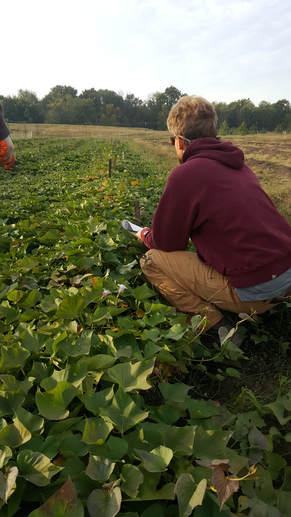Notes from the Field Sweetpotato Seed Systems in the Great Plains

By: Zac Hoppenstedt M.S. Student and Research Assistant
During the depression era, sweetpotatoes were one of the most widely cultivated vegetable crops in Kansas, second only to the botanically distinct Irish potato. Although the state production per capita has declined, sweetpotato root continues to be a significant part of the Midwestern local food economy. Sweetpotatoes are propagated vegetatively. In place of true seed, vine cuttings known as “slips” are sprouted from bedded storage roots in the spring and transplanted in early summer to produce a fresh tuber crop. Regional access to quality planting material is limited and many local growers must rely on shipments from slip producers in the Southeastern U.S.
This season marks the second year of field study at the OHREC for our Strengthening Organic Sweet Potato Propagation Systems project funded by the USDA NCR-SARE. Under the supervision of my advisors Drs. Griffin, Pliakoni, Rivard & Taylor, from the K-State Departments of Horticulture and Natural Resources along with Agricultural Economics, I’ve spent the last year managing trials at multiple sites, comparing the efficacy of sweetpotato slip seedbeds (aka “hotbeds”) grown in high tunnels to those in the open field.
For more than a decade K-State’s John C. Paire Horticulture Center in Haysville, KS has produced high quality organic slips to help meet a tremendous regional demand. In our current study, we are evaluating the potential for local growers to capitalize on this demand by assessing best practices and economic feasibility of slip production systems for individual use and retail.
We’ve successfully collected baseline data for marketable slip yields in dozens of plots and assessed quality parameters (e.g. leaf area, stem diameter, # of vine nodes) and their impact on root production for more than a thousand plant samples grown under experimental conditions. Based on the first year’s data we’ve begun developing enterprise budgets and crop comparison models. The seedbeds will be on showcase at our annual field day and I look forward to sharing what we’ve learned about this unique crop.
Best,
Zac
During the depression era, sweetpotatoes were one of the most widely cultivated vegetable crops in Kansas, second only to the botanically distinct Irish potato. Although the state production per capita has declined, sweetpotato root continues to be a significant part of the Midwestern local food economy. Sweetpotatoes are propagated vegetatively. In place of true seed, vine cuttings known as “slips” are sprouted from bedded storage roots in the spring and transplanted in early summer to produce a fresh tuber crop. Regional access to quality planting material is limited and many local growers must rely on shipments from slip producers in the Southeastern U.S.
This season marks the second year of field study at the OHREC for our Strengthening Organic Sweet Potato Propagation Systems project funded by the USDA NCR-SARE. Under the supervision of my advisors Drs. Griffin, Pliakoni, Rivard & Taylor, from the K-State Departments of Horticulture and Natural Resources along with Agricultural Economics, I’ve spent the last year managing trials at multiple sites, comparing the efficacy of sweetpotato slip seedbeds (aka “hotbeds”) grown in high tunnels to those in the open field.
For more than a decade K-State’s John C. Paire Horticulture Center in Haysville, KS has produced high quality organic slips to help meet a tremendous regional demand. In our current study, we are evaluating the potential for local growers to capitalize on this demand by assessing best practices and economic feasibility of slip production systems for individual use and retail.
We’ve successfully collected baseline data for marketable slip yields in dozens of plots and assessed quality parameters (e.g. leaf area, stem diameter, # of vine nodes) and their impact on root production for more than a thousand plant samples grown under experimental conditions. Based on the first year’s data we’ve begun developing enterprise budgets and crop comparison models. The seedbeds will be on showcase at our annual field day and I look forward to sharing what we’ve learned about this unique crop.
Best,
Zac

